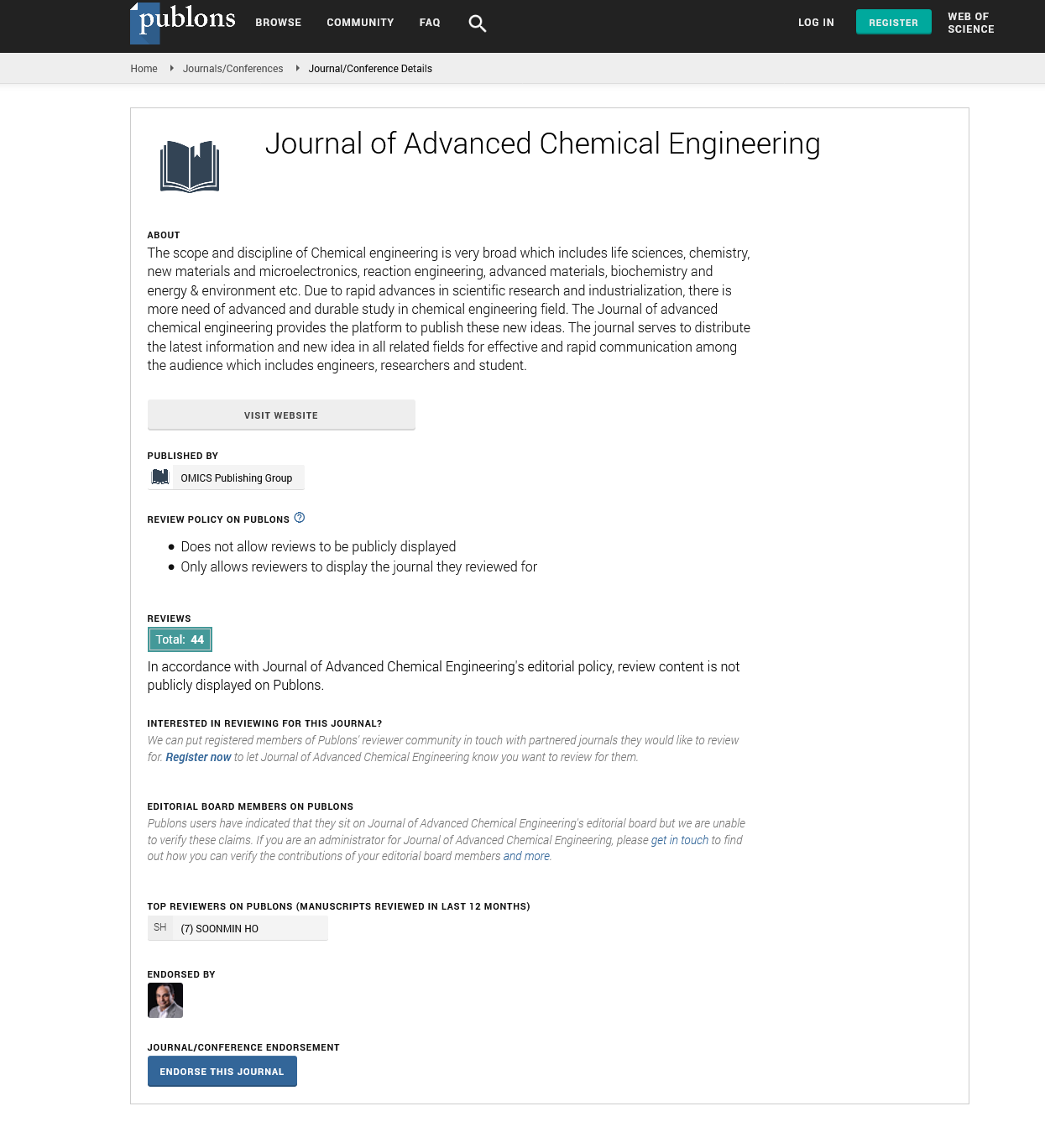Indexed In
- Open J Gate
- Genamics JournalSeek
- Smithers Rapra
- RefSeek
- Directory of Research Journal Indexing (DRJI)
- Hamdard University
- EBSCO A-Z
- OCLC- WorldCat
- Scholarsteer
- Publons
- Geneva Foundation for Medical Education and Research
- Google Scholar
Useful Links
Share This Page
Journal Flyer

Open Access Journals
- Agri and Aquaculture
- Biochemistry
- Bioinformatics & Systems Biology
- Business & Management
- Chemistry
- Clinical Sciences
- Engineering
- Food & Nutrition
- General Science
- Genetics & Molecular Biology
- Immunology & Microbiology
- Medical Sciences
- Neuroscience & Psychology
- Nursing & Health Care
- Pharmaceutical Sciences
Commentary - (2023) Volume 13, Issue 1
Activated Carbon Adsorption: Itâs Principle and Techniques
Jan Yu*Received: 03-Feb-2023, Manuscript No. ACE-22-19696; Editor assigned: 06-Feb-2023, Pre QC No. ACE-22-19696 (PQ); Reviewed: 21-Feb-2023, QC No. ACE-22-19696; Revised: 28-Feb-2023, Manuscript No. ACE-22-19696 (R); Published: 07-Mar-2023, DOI: 10.35248/2090-4568.23.13.267
Description
Since the beginning of this century, adsorption at diverse interfaces has been of interest to scientists. Numerous extremely significant processes with utilitarian value are supported by this occurrence. There is no question about the significance of adsorption in terms of technology, the environment, or biology. The relevance of its practical applications in industry and environmental protection cannot be overstated.
Many catalytic reactions begin with the substrate adsorption phase. More and more, the techniques for separating mixtures in laboratories and on an industrial scale rely on the alteration in component concentration at the interface. Additionally, this issue involves the cleansing of soil, air, water, and sewage. On the other hand, rather than science, art and craft have contributed to the expansion of many fields where technological advancement has addressed adsorption phenomena. The study of interfaces requires exceedingly meticulous experimentation if relevant and reproducible results are to be acquired, hence a fundamental knowledge of scientific concepts is far behind.
Activated carbons are flexible adsorbents with a high surface area, a microporous structure, and a high degree of surface reactivity. They are particularly useful in the adsorption of organic and inorganic contaminants from aqueous solutions. The characteristics and mechanisms involved in the activated carbon adsorption are introduced in Activated Carbon Adsorption.
Adsorption is a quick, affordable, and all-encompassing technique among the different water purification and recycling technologies. The creation of inexpensive adsorbents has sparked a surge in scientific interest in this area. The current protocol outlines experimental procedures for the creation and evaluation of low-cost adsorbents, water treatment and recycling using adsorption technology, including batch processes and column operations. It also discusses key aspects of adsorption. According to laboratory research, there is little permanent organic molecule adsorption on granular carbon. The rate of uptake is therefore in part dependent on the pore size distribution of the adsorbent, the molecular size and configuration of the solute, and the relative electrokinetic properties of adsorbate and adsorbent. It appears that intraparticle diffusion of the solute controls this rate of uptake.
The rates of adsorption will be influenced by systemic parameters like temperature and pH; rates will rise with rising temperature and fall with rising pH. The rate of absorption is a linear function of the square-root of concentration within the range of experimentation, meaning that the beginning concentration of the solute has a significant impact on the rate of uptake.
Adsorbent-adsorbate (refrigerant) pair and adsorption cycle parameters are crucial in the design of adsorption refrigeration/ heat pump systems for a variety of applications. Diverse modelling approaches and various simplifications are used to describe the adsorption-desorption process' performance, and the resulting outcomes are noticeably different. This study provides a thermal model that describes adsorption-desorption cycles in detail and precisely. It is based on the Dubinin-Radushkevich equation and thermodynamic analyses.
According to analysis of adsorption on a uniform surface using the quasi-chemical theory of interaction, the Brunner-Emmett- Teller (BET) theory's hypotheses result in stepwise isotherms if E2=EL and essentially no adsorption beyond the first layer if E1>E2>E3>>EL. The heterogeneous nature of the adsorbing surface is amply indicated for the monolayer adsorption of gases on silver, platinum, and steel. The cooperative analogue of the Freundlich equation is treated for cooperative adsorption on the non-uniform surface.
Citation: Yu J (2023) Activated Carbon Adsorption: It’s Principle and Techniques. Adv Chem Eng. 13:267.
Copyright: © 2023 Yu J. This is an open-access article distributed under the terms of the Creative Commons Attribution License, which permits unrestricted use, distribution, and reproduction in any medium, provided the original author and source are credited.

